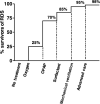Neonatal mortality from respiratory distress syndrome: lessons for low-resource countries
- PMID: 21536613
- PMCID: PMC9923778
- DOI: 10.1542/peds.2010-3212
Neonatal mortality from respiratory distress syndrome: lessons for low-resource countries
Abstract
Respiratory distress syndrome (RDS) is a major contributor to neonatal mortality worldwide. However, little information is available regarding rates of RDS-specific mortality in low-income countries, and technologies for RDS treatment are used inconsistently in different health care settings. Our objective was to better understand the interventions that have decreased the rates of RDS-specific mortality in high-income countries over the past 60 years. We then estimated the effects on RDS-specific mortality in low-resource settings. Of the sequential introduction of technologies and therapies for RDS, widespread use of oxygen and continuous positive airway pressure were associated with the time periods that demonstrated the greatest decline in RDS-specific mortality. We argue that these 2 interventions applied widely in low-resource settings, with appropriate supportive infrastructure and general newborn care, will have the greatest impact on decreasing neonatal mortality. This historical perspective can inform policy-makers for the prioritization of scarce resources to improve survival rates for newborns worldwide.
Conflict of interest statement
Figures
References
-
- Clifford S . The problem of prematurity: obstetric, pediatric, and socioeconomic factors. J Pediatr. 1955;47(1):13–24 - PubMed
-
- Mathews T , MacDorman M . Infant mortality statistics from the 2006 period linked birth/infant death data set. Natl Vital Stat Rep. 2010;58(17):1–31 - PubMed
-
- Lussky R . A century of neonatal medicine. Minn Med. 1999;82(12):48–54 - PubMed
-
- Lawn JE , Kerber K , Enweronu-Laryea C , Massee Bateman O . Newborn survival in low resource settings: are we delivering? BJOG. 2009;116(suppl 1):49–59 - PubMed
-
- Horbar JD , Badger GJ , Carpenter JH , et al. ; Members of the Vermont Oxford Network. Trends in mortality and morbidity for very low birth weight infants, 1991–1999. Pediatrics. 2002;110(1 pt 1):143–151 - PubMed
Publication types
MeSH terms
Grants and funding
LinkOut - more resources
Full Text Sources
Miscellaneous


